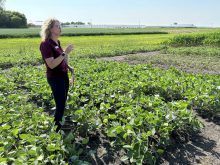World attention was focused last week to the passing of Norman Borlaug, the American scientist known as the Father of the Green Revolution and recipient of the Nobel Peace Prize in 1970 for his efforts to end world hunger.
Borlaug died at the age of 95, still passionately committed to the role science can and should play in helping the world feed itself.
Borlaug is credited with helping to develop and deliver high-yielding wheat varieties and improved farming practices in the 1950s. They were introduced into South Asia in the 1960s and “may well be responsible for saving hundreds of millions of people from starvation,” according to CIMMYT, the non-profit international maize and wheat improvement centre he served for nearly four decades.
Read Also

Manitoba canola industry has new frontiers
Canola oil is still the main priority for the sector, but canola meal is increasingly the subject of research looking for new markets and uses for the oilseed’s byproduct.
Less well known is that his right-hand man for many of those years was a Canadian scientist and formerWinnipegger– R. Glenn Anderson.
Anderson, an Agriculture Canada plant pathologist working on the genetics of rust resistance in bread wheat, was recruited by Borlaug in 1964 to help lead an accelerated wheat-breeding program that was being established in India by the Indian Council of Agricultural Research (ICAR), the Rockefeller Foundation, and the newly formed CIMMYT.
“When Glenn arrived in India, the country had a five-to eight-million-ton deficit that was steadily worsening as food demand increasingly outpaced supply,” Borlaug said in a 1992 address to the Canadian and American phytopathological societies. “Glenn helped to lead a research and production effort that literally put bread into the mouths of tens of millions.”
Anderson ultimately succeeded Borlaug as director of CIMMYT’s wheat program after his retirement in 1979. “His interest, experience and knowledge transcended wheat as a crop; he was a green-fingered agricultural scientist in the broadest context. For example, he understood the many indirect values of forests in food production and erosion control, as a habitat for wildlife and for recreation. This permitted him to see the ‘big picture’ of how to best manage the world’s land and water resources to supply human needs on a sustainable basis.”
Anderson’s career, however, was cut short. He died at the age of 57 after a brief illness in 1981. But as Borlaug describes it, Anderson’s role in the Green Revolution was pivotal because he led the comprehensive extension and human development effort to help farmers maximize the potential of improved genetics.
They soon realized ending hunger was more complicated than simply increasing production; it is a lesson the rest of the world is still learning.
While on a tour of India’s wheat-producing region in 1968, Borlaug and Anderson found the improved production created some new problems. “All the harvesting was done by sickle and it takes three to four times longer to harvest a five-tonne-per-hectare crop than an 800-kilogram-per-hectare crop. The farmers lacked resources for hauling the increased volumes, for threshing, loading and bagging and there were shortages of space, bullocks, carts, bags and grain storage warehouses.
“Unfortunately, there was no shortage of the greedy ‘grain-buyer-moneylenders’ who, with many local markets temporarily flooded with grain, found better opportunities than ever before to beat down the prices paid the farmer,” Borlaug said, noting the Indian government soon moved regulated procurement to stabilize the market and protect farmers.
India quickly became self-sufficient in cereals and ultimately a grain export competitor, which in that sense, placed the efforts of Borlaug’s team at odds with the interests of North American farmers. The massive leap in productivity came at an environmental cost that has led many to question the sustainability of the industrialized farming model.
And despite those productivity successes, people still go hungry. It is notable that in the same week as his passing, the UN’s world food program released news that the number of hungry people in the world has surpassed one billion for the first time in history.
In 1992, and until his dying day, Borlaug passionately defended the need for agricultural innovation, criticizing agriculture’s “environmentalist attackers” mainly from affluent countries who fear pesticides or genetically modified crops and warning against the return to lower-yielding technologies. “World peace will not be built on empty stomachs,” he warned.
However, it is hard to imagine how Borlaug would disapprove of the ways in which the science of sustainable farming systems continues to evolve, such as the UN’s new emphasis on the concept of conservation agriculture.
Borlaug and the team behind the Green Revolution have no need to apologize or defend their efforts. Theirs is a powerful legacy of commitment to using science for the betterment of society. [email protected]



















